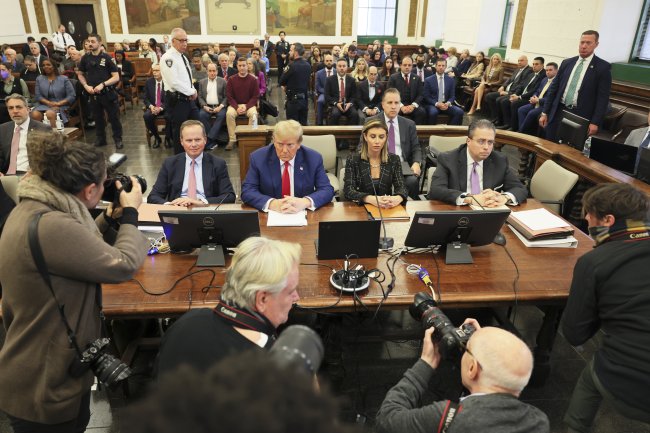The industry tapping K Street to one day dethrone beef
A sesame seed bun packed with lettuce, tomato, onion and a patty grown in a lab with Washington’s help. This is the future of American food, according to a nascent industry that’s firing up a network of lobbyists, trade groups and new campaign spending with an eye towards the 2023 farm bill — a motherlode of funding for meat and agriculture industries. The companies, whose cultivated chicken is now on the menu at restaurants in D.C. and San Francisco, say venture capital money won’t be enough. Now, well before it’s clear whether Americans want to give up traditional hamburgers, they’re jumping into Washington’s influence ecosystem and pressing Congress to expand their access to public financing from the Agriculture Department. “Some country is going to decide to lead the way in creating alternative proteins and creating meat and egg and dairy from plants and precision fermentation and through cultivating cells,” said Josh Tetrick, CEO of Eat Just, which makes one of the two cultivated


A sesame seed bun packed with lettuce, tomato, onion and a patty grown in a lab with Washington’s help.
This is the future of American food, according to a nascent industry that’s firing up a network of lobbyists, trade groups and new campaign spending with an eye towards the 2023 farm bill — a motherlode of funding for meat and agriculture industries.
The companies, whose cultivated chicken is now on the menu at restaurants in D.C. and San Francisco, say venture capital money won’t be enough. Now, well before it’s clear whether Americans want to give up traditional hamburgers, they’re jumping into Washington’s influence ecosystem and pressing Congress to expand their access to public financing from the Agriculture Department.
“Some country is going to decide to lead the way in creating alternative proteins and creating meat and egg and dairy from plants and precision fermentation and through cultivating cells,” said Josh Tetrick, CEO of Eat Just, which makes one of the two cultivated meat products greenlit by regulators for public consumption this year. “We need to ask ourselves whether we want to be buying food from some other country decades from now or would we rather just produce it ourselves.”
Lab-grown — or cell-cultivated and cell-based, as the industry prefers — meat is developed from cells drawn from live animals, combined with a nutrient mixture of proteins and vitamins, and cultivated in large vats that resemble beer breweries.
Although it remains a time-intensive and expensive process, the industry is pitching the technology as a relief for several challenges in American agriculture. Proponents say lab-grown meat can address supply chain and land use problems, alleviate greenhouse gas emissions and improve animal welfare. In reality, their arguments aren’t clear cut yet.
New research reveals the process for making the meat could generate a larger carbon footprint than conventional ranching, and arguments that the products are vegan are often met with skepticism.
The farm bill only comes around every five years, so the last time Congress negotiated one, lab-grown meat — and the messaging game around it — was still in its infancy. Lobbying records show only two organizations in the space hired K Street firms in 2018.
That’s turned around in the past three years: A handful of the most prominent companies formalized a trade group at the end of last year, the Association for Meat, Poultry and Seafood Innovation. A nonprofit, Food Solutions Action, has sprung up to woo lawmakers with campaign donations and experienced lobbyists meant to help usher lab-grown and plant-based products through regulatory hoops and secure taxpayer support.
That coalition, as well as five other companies and advocacy groups involved with cultivated meat, have registered to lobby since 2018, disclosures show, spending at least a collective $3.7 million since 2021. It’s still a fraction of what food giants like Tyson Foods — which spent more than $1 million in the first half of 2023 — or Cargill spend on lobbying in a given year. Still, it reflects an emerging industry’s first real bid to influence federal ag policy.
Eat Just hired leading ag lobbying firm Torrey Advisory Group in 2021, and spent $210,000 last year on lobbyists there who’ve worked on the Senate Agriculture Committee and at USDA. Upside Foods, which has approval to sell cell-based chicken to restaurants, doubled its K Street spending between 2019 and 2022. Finless Foods, a cell-cultivated seafood company that only started lobbying in 2020, spent nearly $300,000 in 2022. And new players are coming in, like Believer Meats, an Israeli cultivated meat company that registered to lobby this year for the first time.
Food Solutions Action, the industry nonprofit promoting “alternative proteins,” spent $370,000 on advocacy last year and is on track to double that figure in 2023. The group also brought on the Russell Group, a prominent ag lobbying firm, in April and its PAC has given campaign cash to congressional appropriators and $18,400 to national Republican campaign committees in the first six months of this year.
Celebrity chef José Andrés’ China Chilcano, a restaurant about a mile from the Capitol, is the first in the country to offer Good Meat-grown chicken — “marinated with anticucho sauce, native potatoes, and ají Amarillo chimichurri” — to patrons. The first round of reservations sold out last month in four minutes, the company said.
But China Chilcano is serving just 3.5 ounces of cell-cultivated chicken for each customer and there’s only enough for eight reservations a week. Producing enough cell-cultivated chicken or beef to supply grocery stores and meet restaurant demand will require scaling up the technology to a whole new level.
“It's a huge technological challenge. It's a huge engineering challenge. It's very capital intensive,” Andrew Noyes, head of global communications at Good Meat, said during an industry briefing for congressional staff this spring. “When it comes to the farm bill, [we’re exploring] whether there are existing programs that help with loan guarantees, that we can potentially, as an industry, leverage to be able to do some of that commercialization work with our vessels and our very expensive manufacturing processes.”
The technology to grow cells has long been used for medical purposes, but on a tiny scale. Constructing the bioreactors — the large steel vats that brew animal cells instead of beer — is costly. One company’s facility for nationwide distribution could cost $450 million, experts say.
To encourage the private-sector financing they need, cell-based meat companies are pushing to expand and make permanent a USDA program that would put a taxpayer guarantee behind loans they take out — and they hope the farm bill can be their vehicle. Tetrick, the CEO of Eat Just, said the farm bill could also boost his industry through funding for more research and development, incentivizing certain crops and offering new financing for facilities.
The industry’s quest to break into a 107-million-lbs. per year U.S. market has plenty of pitfalls.
Some critics don’t see how production costs can fall the way the industry is predicting. Others highlight that certain key scientific advances remain unrealized, such as tech to flex and move the cell-based meat in a way that mimics how cows ramble across a pasture — the behavior that gives beef its meaty texture. And perhaps the most comprehensive study of bringing these new meats to scale found that the technology faces serious obstacles.
The industry acknowledges these hurdles, but argues that technologies like solar power and electric vehicles have seen their costs fall with increased production and innovation. “There are no guarantees in an industry that is stepping into uncharted territory, but our team is hard at work on addressing those scale-up challenges,” Noyes said in a statement to POLITICO.
The industry’s pitch to lawmakers can be a persuasive one that ties in morality, sustainability and global food security, explained Ricardo San Martin, a fermentation scientist and director of the University of California, Berkeley’s alternative meat lab. But the science doesn’t show a viable path for scaling up, he said.
“The politicians are going to listen because it’s emotional,” San Martin said. “I don’t know if those guys have very very savvy scientific advisers that tell them, ‘No, no, be careful with this one.’” Even investors don’t have that scientific guidance, he warned.
But the industry is convinced it can engineer its way out of these scientific roadblocks.
“It's selling out,” Tetrick said of his product. “Where one thought it was science fiction before, José Andrés is selling it in his restaurant. It is on a tasting menu and you can pay for it. It is here right now.”
Before consumers can get lab-grown meat for their barbecues or in a college cafeteria, the industry is clear about what will help solve their technical woes.
“You're going to need support from the federal government,” Tetrick said.
Megan R. Wilson contributed to this report.
What's Your Reaction?













